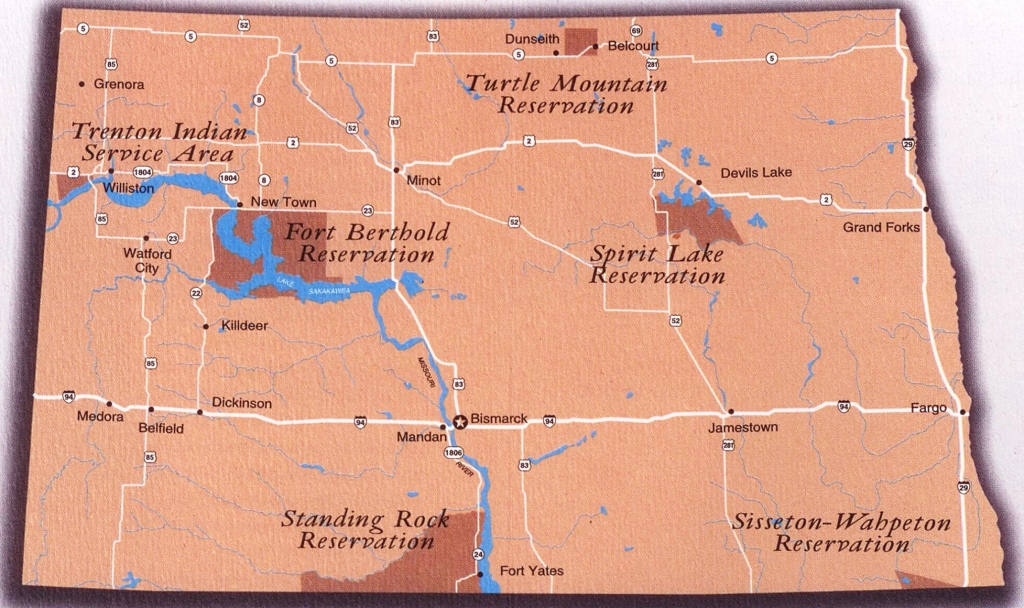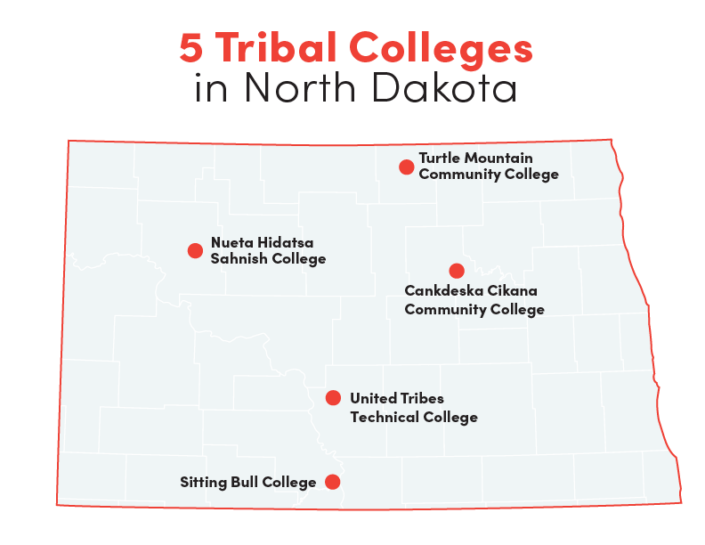North Dakota’s Tribal Lands: A Map of Resilience and Culture
North Dakota’s Tribal Lands: A Map of Resilience and Culture

North Dakota, known for its vast prairies and booming oil industry, is also home to a rich and vibrant Native American heritage. Scattered across the state, like jewels on a rugged landscape, lie seven sovereign tribal nations, each with its own unique history, culture, and traditions. Understanding these reservations is key to appreciating the complex tapestry of North Dakota’s past, present, and future.
A Glimpse into the Past: The Legacy of Treaty Lands
Related Articles: North Dakota’s Tribal Lands: A Map of Resilience and Culture
- Uncover the Rich Legacy: Discoveries and Insights about the Potawatomi Indian Tribes in Michigan
- Unveiling the Cherokee Indian Tribe in Massachusetts: Discoveries and Insights
- Unveil the Tapestry of Native American Heritage: Discover the Tribes of Oklahoma
- Unveiling the Enigma: Native American Reservations in the United States
- Unveil the Enchanting World of Big Cypress Seminole Indian Reservation
For centuries, the land now known as North Dakota was the ancestral home of numerous Native American tribes. The Lakota, Dakota, and Nakota (often collectively called the Sioux), the Mandan, Hidatsa, and Arikara (collectively known as the Three Affiliated Tribes), and the Chippewa (Ojibwe) were just some of the groups who lived and thrived on these plains. Their way of life, deeply intertwined with the land, was disrupted by the arrival of European settlers in the 19th century.
Through treaties negotiated with the U.S. government, these tribes were forced to cede vast portions of their ancestral lands. In return, they were promised protection and the right to live on designated reservations. These treaties, though often fraught with broken promises and injustices, laid the foundation for the reservations that exist today.
Navigating the Map: Seven Sovereign Nations
North Dakota’s map is dotted with seven tribal reservations, each with its own distinct identity:
-
The Fort Berthold Reservation: Home to the Mandan, Hidatsa, and Arikara Nation, this reservation is located in the western part of the state, encompassing a significant portion of the state’s oil-rich Bakken Formation. The Three Affiliated Tribes have played a crucial role in shaping the state’s energy landscape, but they also face challenges related to environmental protection and the impacts of oil development on their land.
-
The Standing Rock Sioux Tribe Reservation: Known for its role in the Dakota Access Pipeline protests, the Standing Rock Reservation lies along the Missouri River. The tribe is fiercely committed to protecting its ancestral lands and waters, and their activism has brought national attention to issues of environmental justice and tribal sovereignty.
-
The Turtle Mountain Band of Chippewa Indians Reservation: Located in the north-central part of the state, this reservation is home to the Turtle Mountain Band of Chippewa Indians, also known as the Metis. The tribe has a rich history of self-reliance and has been actively involved in economic development, including gaming and agriculture.

-
The Spirit Lake Nation Reservation: Nestled in the state’s northeast corner, the Spirit Lake Nation Reservation is home to the Spirit Lake Tribe, known for its strong cultural traditions and vibrant arts scene. The tribe is also a leader in environmental stewardship, working to protect the pristine waters of Devils Lake.

The Sisseton Wahpeton Oyate Reservation: This reservation spans the border between North Dakota and South Dakota. The Sisseton Wahpeton Oyate, a Dakota tribe, has a long history of resilience and has been actively involved in education, healthcare, and economic development.
-
The Fort Totten Reservation: Home to the Devils Lake Sioux Tribe, the Fort Totten Reservation is located in the northeast corner of the state. The tribe has a strong emphasis on preserving its language and cultural traditions, and it has been actively involved in promoting economic development through tourism and agriculture.
-
The White Earth Reservation: While most of the White Earth Reservation is located in Minnesota, a small portion extends into North Dakota. The tribe, known as the White Earth Nation, has been a leader in promoting tribal self-determination and has been actively involved in economic development, education, and healthcare.

Beyond the Map: Challenges and Opportunities
While these reservations represent a vibrant tapestry of Native American culture and resilience, they also face significant challenges. Poverty, unemployment, and lack of access to quality healthcare are persistent problems on many reservations. The legacy of colonialism, including broken treaties and forced assimilation, continues to impact the lives of Native Americans in North Dakota.
However, there are also signs of hope. Tribal governments are increasingly taking control of their own destinies, working to develop their economies, improve education, and protect their environment. They are also actively engaging with state and federal governments to ensure their voices are heard and their rights are respected.
A Journey of Understanding
Visiting a North Dakota reservation can be a transformative experience. It’s an opportunity to learn about the rich history and culture of these sovereign nations, to witness their resilience in the face of adversity, and to gain a deeper understanding of the complex relationship between Native Americans and the United States.
Whether you’re interested in exploring the stunning landscapes, learning about traditional arts and crafts, or simply engaging in meaningful dialogue with tribal members, a visit to a North Dakota reservation can be a journey of discovery and enlightenment.
FAQ: Indian Reservations in North Dakota
1. What are the names of the Indian reservations in North Dakota?
North Dakota is home to seven tribal reservations:
- Fort Berthold Reservation
- Standing Rock Sioux Tribe Reservation
- Turtle Mountain Band of Chippewa Indians Reservation
- Spirit Lake Nation Reservation
- Sisseton Wahpeton Oyate Reservation
- Fort Totten Reservation
- White Earth Reservation (partially in North Dakota)
2. What tribes live on these reservations?
The tribes living on these reservations are:
- Mandan, Hidatsa, and Arikara (Three Affiliated Tribes) – Fort Berthold Reservation
- Standing Rock Sioux Tribe – Standing Rock Sioux Tribe Reservation
- Turtle Mountain Band of Chippewa Indians – Turtle Mountain Band of Chippewa Indians Reservation
- Spirit Lake Tribe – Spirit Lake Nation Reservation
- Sisseton Wahpeton Oyate (Dakota tribe) – Sisseton Wahpeton Oyate Reservation
- Devils Lake Sioux Tribe – Fort Totten Reservation
- White Earth Nation (Chippewa) – White Earth Reservation (partially in North Dakota)
3. What are some of the challenges facing these reservations?
Many reservations in North Dakota face challenges such as:
- High poverty rates
- Unemployment
- Limited access to healthcare
- Lack of infrastructure
- Environmental issues
4. What are some of the opportunities for these reservations?
There are opportunities for economic development, education, and cultural preservation on these reservations. These include:
- Gaming
- Tourism
- Agriculture
- Renewable energy
- Tribal self-governance
5. How can I learn more about the reservations in North Dakota?
You can learn more about the reservations in North Dakota by:
- Visiting the websites of the individual tribes
- Visiting the reservations themselves
- Attending cultural events and festivals
- Reading books and articles about Native American history and culture
6. What are some ways I can support Native American communities in North Dakota?
You can support Native American communities in North Dakota by:
- Visiting reservations and supporting local businesses
- Donating to tribal organizations
- Advocating for policies that support tribal sovereignty
- Learning about and sharing Native American history and culture
7. What is the significance of the Standing Rock Sioux Tribe Reservation?
The Standing Rock Sioux Tribe Reservation gained national attention during the Dakota Access Pipeline protests. The tribe has been a vocal advocate for environmental protection and tribal sovereignty.
8. What are the legal statuses of these reservations?
These reservations are sovereign nations, recognized by the U.S. government. They have their own governments, laws, and courts.
9. Are there any restrictions on visiting these reservations?
There are no restrictions on visiting these reservations, but it is important to be respectful of tribal customs and traditions. It’s always a good idea to reach out to the tribe’s tourism office or website for information on visiting.
10. How can I get involved in supporting the rights and well-being of Native Americans in North Dakota?
You can get involved by:
- Joining organizations that advocate for Native American rights
- Volunteering with tribal organizations
- Participating in events and rallies that support Native American causes
- Educating yourself and others about Native American history and culture
A Final Thought:
The reservations of North Dakota are not just geographical spaces on a map. They are living, breathing communities with a rich cultural heritage, vibrant traditions, and a strong commitment to self-determination. By understanding and appreciating these reservations, we can help to foster a more just and equitable future for all.

Closure
Thus, we hope this article has provided valuable insights into North Dakota’s Tribal Lands: A Map of Resilience and Culture. We hope you find this article informative and beneficial. See you in our next article!


